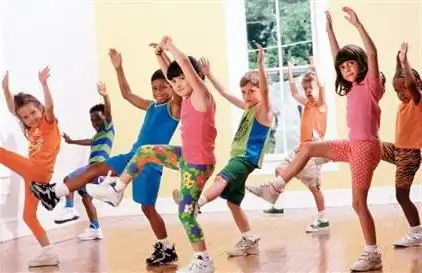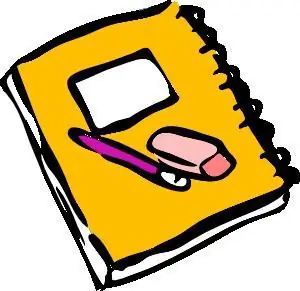2025 Author: Priscilla Miln | [email protected]. Last modified: 2025-01-22 17:55:29
The federal educational standard directs teachers to search for innovative technologies, means, methods and techniques that would solve the problems of developing the child's personality, his cognitive and creative abilities. A project in a kindergarten in the middle group is a good opportunity to realize all this by integrating different educational areas.
Interesting and useful thing
In the modern sense, a project is a kind of problem that needs to be solved. If there is such a problem, then it remains to formulate it and create a project. Such projects, growing from a pressing issue, are more efficient and effective. In reality, there are other cases - the competition of projects announced in the preschool educational institution forces teachers to “think up” a problem: on the one hand, this can push them to work, and on the other hand, create a project for the sake of the project, “for show”. If the topic is relevant, the project activity is exciting and interesting for all participants.

Whenstart?
With children of what age can a project be implemented in kindergarten? In the middle group, children can already be participants with the support of adults, as they grow older, they become active partners in the project, but even the smallest children may well be included in project activities.
Coming to the garden, the kids are just adapting to new conditions, so every effort is made to make this process as favorable as possible. And by the age of 4-5, having settled into a preschool institution, children are ready for a variety of activities, including project activities.
In design technology, the child-adult ratio is based on participation. At first, children carefully observe the activities of their elders and take part in them to the best of their ability, gradually becoming equal partners and coming to cooperation. In our article, we will take a closer look at how to properly organize projects for children of the middle group.
Age-appropriate activities
Children of four years old have some characteristics that you need to know when including them in a project.
- In middle-aged children, physical abilities increase, they become more active. Ready-made projects will help direct this emerging energy in the right direction. In the middle group, they may be different in subject matter, but should be understandable for four-year-olds.
- Four-year-olds often show increased excitability. Noticing such a state in the group, the teacher must quickly take action. It's best to divert the kids to somethinginteresting. Properly organized activities within the framework of the project will help restore strength and relax, relieve stress, it is good if it is diverse - both mobile and calm, but always emotionally colored. At the same time, the physical and mental development of children occurs.
- New opportunities appear in communication with peers. A project in kindergarten in the middle group should include various games that unite, teach to interact.
- It becomes especially important for children to get the approval of adults, to do something together, these needs can also be met in project activities if not only teachers, but also parents are involved in it. In a joint business, mutual understanding is formed, the joy of communication arises.

Who can implement the project?
Children, educators, professional educators and parents can participate. At the beginning of work on the project, it may seem that children are doing what adults have planned, but in the process it turns out that, due to their age characteristics, they actively participate and can even propose and plan, they can compare, analyze, and explore. In well-organized activities, children not only follow the rules and requirements, but also create masterpieces, create, design, evaluate.

How to choose a project theme?
The focus of projects sometimes appears unexpectedly: anything can become the topic of a project. Children of this age are interested in everything around,want to understand what is going on. The child's question about why the snowman melted can serve as an impetus for activity. The Spring project in the middle group will help children master the signs of spring, understand why the snow darkens and melts. Games expand children's knowledge and ideas about the world around them. Working on a project, you can acquaint children with literature about spring, observe changes in nature while walking in the garden and with parents, learn poems and songs, look at illustrations, paintings and photographs, experiment with snow, draw, make applications. The Spring project in the middle group will help organize creative interaction between children and parents in a variety of activities to study spring signs.

How are educational areas integrated in the project?
The project in kindergarten in the middle group provides an opportunity to integrate educational areas, and therefore, the full development of the child's personality. Let's look at an example of how this can be done within the framework of one project. In preparation for May 9, the project "Victory Day" will be relevant. The middle group can use different forms of work, while there will be a diversified development of children:
- Cognitive development will be the study of historical facts and events accessible to the understanding of children.
- Speech development is facilitated by the enrichment of the active vocabulary of children, acquaintance with fiction, memorizing poetry, compiling stories.
- Musical andthe literary material used in the work on the project carries out the artistic and aesthetic development of children, they listen to songs of the war years, read poetry, try to express themselves in artistic and creative activities (for example, through drawing).
- If adults - parents, teachers - and children become participants in the project, this will make it possible to realize the social and communicative development of children - they interact with adults with interest during joint events, exhibitions, a trip to the monument to fallen soldiers, this should cause they are vivid emotional manifestations.

What is the sequence of work on the project?
The initial stage is preparatory, when the problem, goals are defined, the result is predicted, software and methodological support for the project implementation is selected, and the experience of other teachers on the project topic is studied. Consider, for example, "Defender of the Fatherland Day". By implementing such a project, the middle group on February 23 can hold a holiday for boys and dads. The problem is how to mark the upcoming date. The goal is to congratulate the future and real defenders of the Fatherland, the expected result is the positive emotions of children and adults from the event.
The next step is diagnostic: surveys, observations, studies to study the state of the problem at the time of the start of work on the project are carried out. In the preparation we are considering for February 23, a survey of parents and children about the form of the upcoming holiday can be used, it will be interestingvideo survey of children asking them to tell about their dad. Moments of it will be showcased during the event.
The most interesting thing is the work itself on the project - the creative stage, at which, in fact, there is a joint movement towards the result. The developed scenario of the event and its implementation will be the essence of this stage. Additional use of other forms of work is also possible: organizing a photo exhibition “Our Grandfathers and Dads”, an exhibition of drawings “Our Army”.
The work on the project is completed, as a rule, with a presentation, analysis of goals and results, study of the results of activities, evaluation of the project and the search for further development prospects. You can ask participants to leave feedback immediately after the event, or do an analysis later, taking into account what worked and what didn't.

How to work on a project?
Today's living conditions make environmental projects especially relevant. The types of activities, forms and methods of work can be different: thematic classes on the project, children's games, joint activities with adults, visual information for parents accompanying the work on the project, creative work of families. Diagnostic methods complement the project well: questioning and observation, as well as research methods - children become experimenters, studying the world around them.
Environmental projects can have a specific focus, for example, children and adults can plant a "Family Alley", make bird feeders or clear a spring fromgarbage. Such a result will please children, they will be proud of their useful deeds done together with their parents.

What are the main benefits of project activities?
Working on a project is an interesting, creative process, its integrated nature allows you to teach children to act independently and actively, think creatively, find knowledge and use it in different ways. In addition, the project is a great opportunity to involve parents in the life of the garden.
Recommended:
Speech therapy classes for children (2-3 years old) at home. Speech therapist classes with children 2-3 years old

When a child at 2-3 years old does not speak, parents panic. It seems to them that if the neighboring children speak very well, then their baby is lagging behind in development. However, it is not. Speech therapists say that each child is individual. Non-speaking children can be taught at home. In this article, you can find exercises, tips and tricks that will help keep your child interested
Synopsis "Physical training in the senior group". Summary of thematic physical education classes in the senior group. Summary of non-traditional physical education classe

For children of older groups, many options for organizing a lesson are prescribed: plot, thematic, traditional, relay races, competitions, games, with elements of aerobics. When planning, the educator draws up a summary of thematic physical education classes in the older group. Its main goal is to show children how to strengthen and maintain he alth with the help of general developmental exercises
Classes in the preparatory group for GEF. Classes in drawing, ecology, the world around

Classes in the preparatory group should prepare the child for school. The best way is to learn by playing. This opportunity is provided by new standards of education
Classes on the development of speech in the middle group. Analysis of the lesson on the development of speech

Classes on the development of speech in the middle group are held in order to form the correct speech skills in the child in accordance with the age category. The degree of adaptation among peers, as well as further education in primary school, depends on the correct pronunciation and the ability to express one's own thoughts
Average group of kindergarten. Classes in the middle group

The article describes the features of teaching and educating children of the middle group of kindergarten. It is noted how they differ from pupils of other groups. It is told how to properly organize the environment so that it contributes to the development of children. The program tasks are presented, which must be adhered to when planning the activities of children in kindergarten. The article will be useful to teachers of preschool institutions

